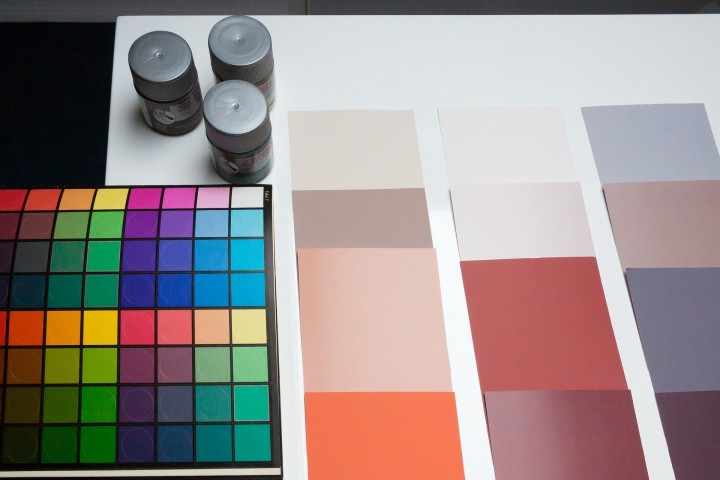Johannes Itten - Founder of the Theory of Color Types
The Swiss Johannes Itten (1888-1967) was an art educator, art theorist, painter and a busy person. At first he was a primary school teacher in Bern, later he studied art in Geneva and natural sciences in Bern. Itten is considered the founder of the theory of color types and the forefather of color consulting. His findings are still used in the planning of living and office spaces and in printing technology, where his CMYK model has become established. The twelve-part color wheel contains the primary colors yellow, red and blue and the complementary colors green, orange and violet, as well as mixtures of the colors with each other in different ratios. Black and white are not considered colors. The mutual influence of colors was described by Itten in seven color contrasts: Color-at-itself, Light-Dark, Cold-Warm, Complementary, Simultaneous, Quality and Quantity.
The effect of contrasts
As soon as colors come together, a contrast is created that has an effect on the viewer. Two primary colors have a cheerful and childlike effect and are well and gladly used in children's rooms. Light and dark alternately intensify each other, this form of contrast is usually present. Cold and warm colors in combination express something opposite, coldness in painting suggests distance. The quality of a color means the purity of color gradations, such as red compared to pink, the quantity means the size of different color blocks, which achieve a different effect depending on their dimensions. Complementary colors have a harmonious, appealing and balanced effect. Simultaneous are bright colors from the neighborhood of the color wheel (not complementary), which have a stimulating to biting effect. Harmony, excitement and depth of space are the tools for strong staging.
Life and work
Between 1913 and 1916, Johannes Itten adopted Adolf Hölzel's theory of color contrast at the Stuttgart Academy and developed the doctrine of color types, which divides all people into four different categories according to the seasons of spring, summer, autumn and winter. While spring and autumn belong to the warm types, Itten counted summer and winter among the cold ones. The skin tone, the complexion as well as the hair color and the color of the eyes played a role. Itten found out in experiments that people are attracted to colors that also dress them best, that look best on them. Itten was also concerned with the effect of colors on people, such as red for warmth and blue for cold. Colors meant "light made music" to Itten.
Johannes Itten at the State Bauhaus in Weimar
Johannes Itten survived the end of World War I in Vienna, where he founded his own art school in order to survive economically. There he met architect and Bauhaus founder Walter Gropius, who brought him to the Staatliches Bauhaus in Weimar in 1919 as one of the first artists to become a Werkmeister. The Bauhaus wanted to unite art and craft and break new ground after World War I, straight geometric lines instead of superfluous flourishes - the beginning of modern design. In Weimar, the Bauhaus master set up a painter's studio in the Tempelherrenhaus, a "salon in the park" remodeled for the princely court in 1786. At the Bauhaus, Itten established the preliminary course, a kind of creativity laboratory, which was to lay the foundation for the further artistic development of the young students. He was concerned with expanding the young people's thinking, inspired by reform pedagogy. The creative spirit should be awakened, the young artists should work intuitively instead of over their heads. Material studies and sculptures made of garbage were created. In the Tempelherrenhaus, the lesson began with physical and breathing exercises. Itten's clothing became known as the Bauhaus frock, it was spiritually inspired, in search of Western-Eastern connection. In the conflict over which purpose the Bauhaus should serve, art itself or industry, Gropius won. Itten was among the critics of industrialization and mass production; Gropius wanted to develop prototypes for industry. Itten went back to Switzerland. The preliminary course in art education, modern pedagogical approaches and the color type theory have endured to this day. His students say about him that he helped them find their own style - the high art of pedagogy.
Itten's life after the Bauhaus
Between 1923 and 1926, Itten joined the reformed Zarathustrism, the Mazdaznan Temple community, in Herrliberg, near Zurich. There he also founded the Ontos Art School and the hand weaving workshop Ontos Werkstätten. From 1926 to 1934 IItten founded his own art school in Berlin, and from 1932 to 1938 he directed the Fachschule für textile Flächenkunst in Krefeld. After being dismissed by the National Socialists, he went to the Netherlands to emigrate from there to the USA. Instead, he became director of the Zurich School of Arts and Crafts from 1938 to 1954 and headed the Museum Rietberg in Zurich from 1952 to 1956. Back in Germany, he taught the first students at the new Hochschule für Gestaltung in Ulm. Itten wanted to paint again, and he spent his last years painting a lot in his small studio near Zurich, which has been preserved almost in its original condition and remains in family ownership to this day. There he created over 600 originals, oil paintings, watercolors and drawings. His daughter, historian Marion Lichardus-Itten (b. 1941), is president of the Johannes Itten Foundation, founded in 1992 and based at the Kunstmuseum Bern, which researches the artist's work. Important Bauhaus architects such as Walter Gropius, Marcel Breuer and Ludwig Mies van der Rohe significantly influenced architecture in the U.S. after their escape from Nazi Germany.

